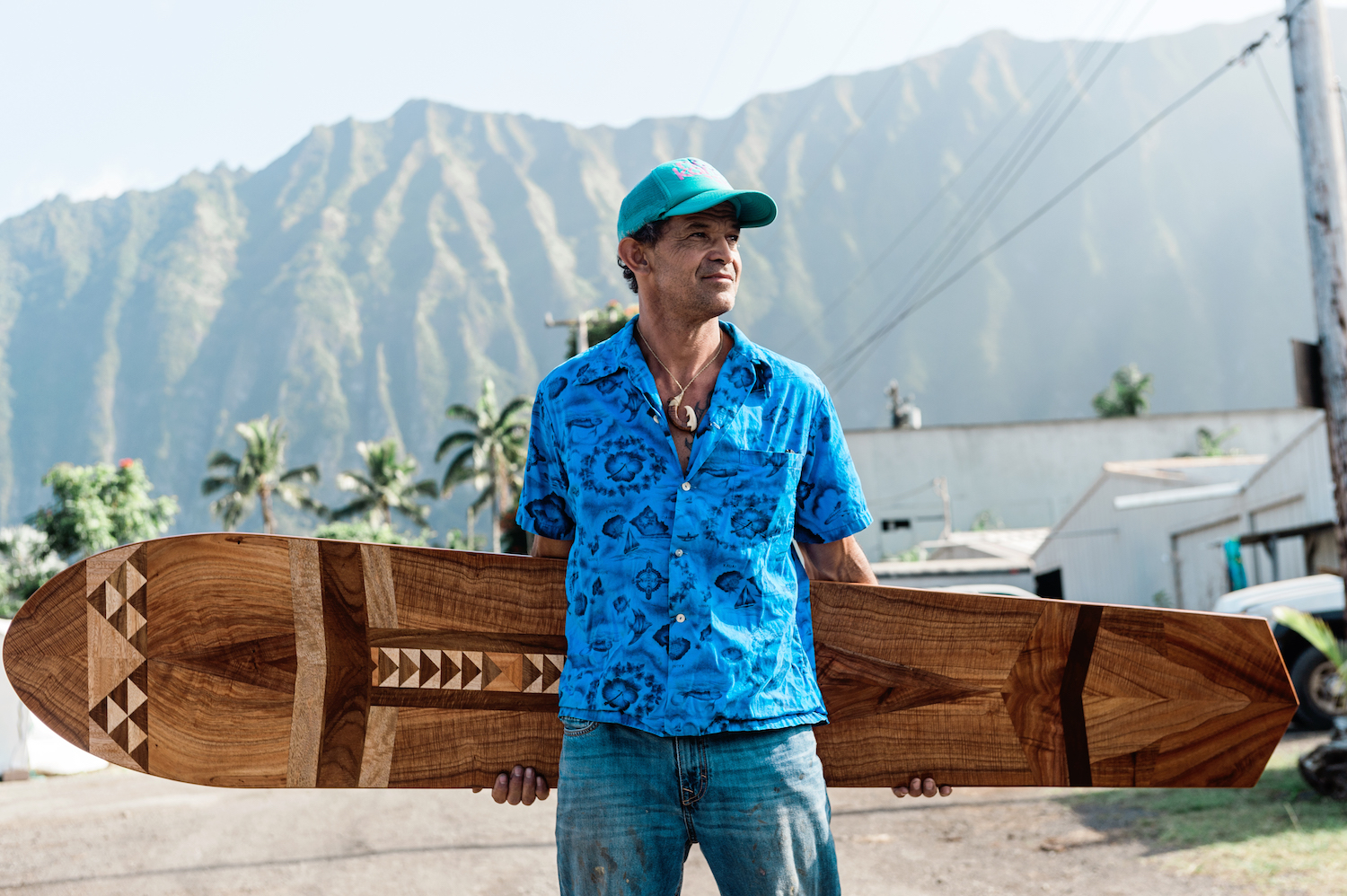More than mere decorative objects, Leleo Kinimaka’s traditional wooden surfboards are the result of a family legacy spanning 17 generations.
In between morning heats at the Buffalo Big Board Surf Contest on O‘ahu’s west side, Leleo Kinimaka plants his latest creation in the sand. It’s an alaia, a type of traditional Hawaiian wooden surfboard, which he created with indigenous tropical hardwoods sourced from six separate locations across the islands.
“I see this as a presentation of modern Hawaiian culture,” Kinimaka says, admiring his handiwork. “This is pretty technical, but it is still Hawaiian wood, and a Hawaiian design. The triangle patterns are the teeth of sharks, symbols of power,” he says, before being interrupted by a stream of surfers and beachgoers who stop to ask Kinimaka questions about the board’s intricate artistry, which diffracts the rising sun like a small obelisk.
I see this as a presentation of modern Hawaiian culture.


Just a short while ago, nary a surfer even knew what an alaia was. But since surfboard shapers like Tom Wegener and Tom Pohaku Stone began making these traditional boards in the early 2000s, surfboard manufacturing and riding has been returning to its pre-western Polynesian roots, and wooden boards are now being made, sold, and ridden in Australia, California, and throughout Hawai‘i.
Surfboard shapers have created alaia as functional, small-wave tools both devoid of ornamentation, as well as highly decorative forms of art. Kinimaka’s boards occupy the decorative end of the spectrum and are sought by collectors around the world.
It’s easy to see why: Glowing in the sun, Kinimaka’s alaia looks like a cross between the work of 13th century Moorish tile designers and 20th century surfers—a surfboard fit for a true sultan of the beach.
For Kinimaka, intricate surfboard and canoe-paddle design is the result of a generational relationship with the ocean. The sprawling Kinimaka family tree, which the shaper can trace back 17 Hawaiian generations, includes professionals of all calibers and is known for producing several famous watermen and waterwomen.
“My grandfather was a surfer, and my dad was a beachboy in Waikīkī during the ’40s and ’50s, a beach captain,” says Kinimaka, whose father met his mother on those same shores. “‘Hey let’s go surf,’—it’s the ultimate pick-up line,” he jokes.
Kinimaka grew up surfing and paddling canoes on Kaua‘i, like generations of his family before him. Yet he was forced to find new work after Hurricane Iwa blasted through the islands in 1982. “All us lifeguards, waiters, and surf instructors ended up in construction when people stopped showing up. I learned carpentry, and have been doing it ever since,” he explains. “The ocean and the land provide. This is how I’ve been able to feed my family.”
Carpentry allowed Kinimaka to surf and work throughout the Pacific’s modern diaspora. After decades-long stints in Southern California and Hawai‘i Island for work and play, Kinimaka set up a custom woodshop in Waimānalo, where he makes canoe paddles, surfboards, jewelry, and decorative displays. At this shop, which he still runs, nothing goes to waste.
The wedges and shims that remain after the construction of couches and ottomans are repurposed to create surfboards and paddles. Then, the thumb-sized pieces that still yet remain are repurposed into jewelry. On the beach, Kinimaka shows those who stop to admire his alaia a delicately carved fishhook pendant he wears that matches the curled, golden inlay of the board.
Working on boards and paddles is a passion for me, even if these things end up as décor.


Local and international galleries and shops have clamored for Kinimaka’s work to adorn their walls while reflecting modern, indigenous tastes. He has a waitlist of orders.
“We’ve been profitable for eight years now doing custom work,” he says with a smile. “No more construction for me.” These days, Kinimaka makes more time to surf and paddle.
Last year, in his 50s, he and his tandem surfing partner, Megan Talibus Anderson, took fourth place in the International Tandem Surfing Association’s ratings, which were tabulated across seven contests held at surf breaks around the world.
He has crossed the treacherous Ka‘iwi Channel between Moloka‘i and O‘ahu 24 times on a variety of watercraft.
“Working on boards and paddles is a passion for me, even if these things end up as décor,” Kinimaka says between talking with visitors on the beach. “See, everybody asks me how long that board took to make. Really, it doesn’t matter. I don’t keep track, I enjoy it too much.”

